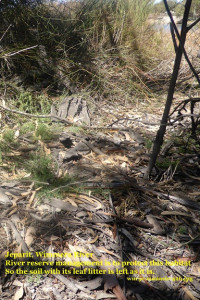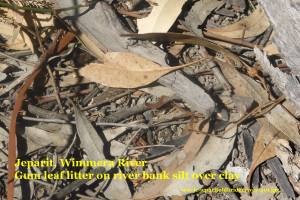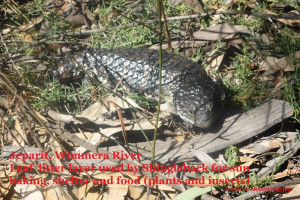Soil for a lizard’s home

 Description: leaf litter layer over sandy silt
Description: leaf litter layer over sandy silt
Location: gentle slope of verge above steep bank of the Wimmera River at Jeparit
Lizard Habitat Values of this river verge soil
Soil grows plants for reptile habitat (e.g. Shingleback/’Stumpy Tailed’ Lizard) providing:
Shelter
 – ground cover here is salt tolerant,
– ground cover here is salt tolerant,
– leaf litter from the trees and bushes and old logs to rest in
– and sunlit spaces from the canopy for sunlight to ‘heat up’
– Foods
– insects and ground cover (like Ruby Saltbush in photo left) living in this soil, its ground cover and lower plants
Challenges of this soil providing Shingleback Lizard habitat under processes operating naturally as management in a Park Reserve
– Soils dry out in summer reducing plant cover
– Soils may go under water in high flow and flood events, drowning any hibernating lizards
– Salinity and drought may reduce the thickness of ground level plant cover available for shelter and food resources
See more about
-the Shinglebacks and their habitat from the Australian Museum
– soil functions along the Wimmera River in these Jeparit and Lake Hindmarsh Soil Selfies
– soils supporting natural habitats in Soil Selfies from Barrett Reserve in the Wimmera, Pine Plains in the Mallee, Mt Poole in the Outback, the Styx Forest in Tasmania, and Silkeborg Forest in Denmark and in LN post
Credits: Photos and page created by Jeanie Clark, enviroed4all®, Warracknabeal, for use in education under a (cc) licence 2015
return to lists of Soil Selfies
page published 31 July 2015, updated 10 January 2016
